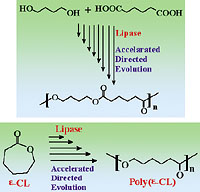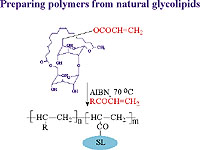
Home
- NSF
- ENG
- EEC
- I/UCRC Program
Information and Communications
Fabrication & Processing Technology
Qualtiy, Reliability, & Maintenance

Center for Biocatalysis and Bioprocessing of Macromolecules (CBBM)
Polytechnic University
A National Science Foundation Industry/University Cooperative Research Center since 2000
Biocatalysis provides important options to reduce process energy consumption, increase control over product structure/properties, and reduce toxic chemical use and by-product generation
 Center Mission and Rationale
Center Mission and Rationale
Enzyme catalysis is a powerful tool that has not yet received adequate attention in Polymer Science. Enzymes operate under mild conditions, with impressive selectivity, on a diverse range of natural and non-natural substrates. These characteristics provide exciting opportunities to furnish additional control of polymer structure without adding processing steps. The opportunity to synthesize polymers at reduced temperature in the absence of heavy metal catalysts is of great importance. The rapid pace of developments in biotechnology that have made available a wide array of enzymes, as well as powerful techniques to further evolve these enzymes for specific chemistries, has set the stage for real progress in reaching commercial targets. This new Center is organized to provide its Industrial Members with critical cutting-edge research on enzyme transformations related to polymer technology, putting them in a position to critically assess the impact that biocatalysis and bioprocessing might have on their short- and long-term business strategies.
Research Program
The Center for Biocatalysis and Bioprocessing of Macromolecules (CBBM)
develops and uses whole-cell and cell-free enzyme systems to carry out
the synthesis and modification of monomers, macromers, and polymers. The
following are examples of current Center research activities:
 Synthesize polymers from vinyl monomers at ambient reaction temperatures
Synthesize polymers from vinyl monomers at ambient reaction temperatures
- Evaluate process parameters and economics of enzyme-catalyzed transformations
- Develop specialty functional monomers that add value to existing products
- Identify/demonstrate opportunities to substitute heavy metals with catalytic proteins
- Carry out mild polymer-polymer transesterification reactions without forming colored impurities or loss in product molecular weight
- Develop an understanding of how immobilized matrices and surfactants can be better designed to enhance enzyme activity and stability
- Carry out ring-opening and condensation polymerizations to prepare polyesters, polycarbonates, and an array of unique block copolymers
- Make selective modifications of functional polymers to control side-group structure and distribution
- Develop mild methods to control the rate, extent, and conditions that trigger polymer crosslinking
- Carry out surface modifications of fibers and films
- Develop simplified routes to complex but well-defined polymers such as dendrimers and hyperbranched systems
- Synthesize macromers with extraordinary levels of structural control
- Conduct microbial synthesis and modification of polysaccharides
- Synthesize polymers from amino acids.
 In addition to participating in the Industry/University Cooperative
Research Center Program, the CBBM also has extensive non-core research
activities that are independently funded. Examples of non-core research
projects are as follows:
In addition to participating in the Industry/University Cooperative
Research Center Program, the CBBM also has extensive non-core research
activities that are independently funded. Examples of non-core research
projects are as follows:
- Synthesis of water-soluble biocompatible polymers for targeted drug delivery
- Development of biocompatible/bioerodible polymer matrices to direct cell growth and differentiation for tissue engineering
- Creation of well-defined microbial glycolipids and lipoheteropolysaccharides for personal care and biomedical applications
- Control of the composition, repeat unit sequence distribution, molecular weight, and end-group structure of polymers prepared by microbes. Examples of microbial polymers under study are polyhydroxyalkanoates, γ-poly(glutamic acid), cellulose, curdlan, and pullulan
- Use of accelerated evolution strategies to develop enzymes and microbes with extraordinary catalytic activities
- Development of methods for the microbial conversion of waste materials to value-added products.
Special Center Activities
The CBBM understands that its role is much more than providing cutting-edge research results. Therefore, the Center actively works to enhance its value to members by the following methods: 1) development of professional workshops on biocatalysis that are made available for presentation at member sites; 2) sending students to work with member companies on cooperative research projects; 3) encouraging member company scientists to work in the Center research laboratories so that they can gain practical experience in Center technology; 4) maintaining and making available an up-to-date database on journal publications, books, and patents in the field; 5) catalyzing relationship-building between member companies that leads to profitable business partnerships; 6) taking the lead in organizing international symposia to advance Center research and member technical goals; 7) creating simple paths by which member companies can develop individual agreements with the Center to carry out non-core proprietary projects; and 8) providing members with technical summaries of symposia attended by Center staff.
Facilities
The CBBM facilities are housed at the Polytechnic University in Brooklyn,
New York. The CBBM's equipment and instrumentation includes: Microbiology:
Normal array of sterile hoods; deep freezer (-80oC, Revco Ultima II),
Freeze dryer (Labconco); Floor Model shaker/incubators (multiple); refrigerated
centrifuges; autoclaves of various sizes; Bioflo 3000 reactors with associated
probes and chiller (New Brunswick); Electrophoresis Equipment; Temperature
and humidity controlled incubators (Thermotron, multiple);
Spectrometers: UV/VIS/NIR Absorption (Varian Cary 50Bio UV-Visible
Spectrophotometer, Shimadzu UV-1601 UV-Visible spectrometer); Infrared
Spectroscopy (Perkin-Elmer PE-1600 FT-IR, Nicolet 760 FT-IR); Fluorescence
Spectroscopy (Perkin-Elmer Luminescence Spectrophotometer 50B); Circular
Dichroism (Jasco J-710 Spectropolarimeter, Perkin-Elmer 241 polarimeter);
Dielectric Spectroscopy (HP 4284, HP 8752); NMR-Spectrometer (BrukerDRX-300);
Mass Spectrometer (Brucker Proflex III MALDI-TOF Mass Spectrometer);
Light Scattering: Differential Refractometer (Chromatix KMX-16
Laser Differential Refractometer), Static Light Scattering (LS-230 Coulter
Particle Size Analyzer, Wyatt Dawn DSP light Scattering Instrument), Dynamic
Light Scattering (Coulter N4 Plus Submicron Particle Sizer);
Chromatography: GC (Perkin-Elmer 850); HPLC (gradient system fitted
with RI and U.V detector); GPC (2 Waters systems using aqueous or organic
solvent, with RI detector, Viscotek T-60 Viscosity/Light Scattering Dual
detector and/or Wyatt Dawn DSP Multiangle Light Scattering detector);
Thermal Analysis: Differential Scanning Calorimeters (TA Instruments
Modulated DSC 2920, Perkin-Elmer DSC system 7); Thermogravimetric Analyzer
(TA Instruments High Resolution TGA 2950); Dynamic Mechanical Analyzer
(TA Instruments Four Mode 983 DMA);
Microscopy: Hitachi H-800 Scanning Transmission Electron Microscope,
Hitachi S-570 Scanning Electron Microscope, Digital Instruments NanoScope
III Atomic Force Microscope;
Surface Analytics: Kruss Processor Tensiometer K12; Kruss Bubble
Pressure Tensiometer BP2; Kruss Drop volume Tensiometer DVT-10; Kratos
dual chamber surface analysis system with X-ray Photoelectron Spectroscopy;
Water Purification: RiOs-16 Milli-Q synthesis (water purification
unit);
X-ray Diffraction: Philips wide angle X-ray powder differactometer;
Combinatorial Synthesis Robot: Charybdis Technology ILIAD Personal
Synthesis System.
Center Headquarters
Center for Biocatalysis and Bioprocessing of Macromolecules
Polytechnic University
Six Metrotech Center
Brooklyn, NY 11201
Tel (718) 260-3984 * Fax (718) 875-9646
Homepage: chem.poly.edu/gross/
Center Director: Professor Richard A. Gross
rgross@poly.edu
Center Evaluator: S. George Walters
(910) 329-0824 * s.george.walters@worldnet.att.net
|
|
|
||||||||||||||||